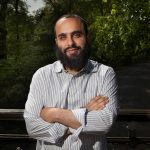Elad Nehorai

Proposition 3- Community/Kehillah
“At a time when technology has made meaningful social intercourse much harder to come by, the Jewish community must offer places where people can find support in times of need, communal celebration in times of joy, and friendships to make life fulfilling.”
Hevria is built on the assumption that creative and out-of-the-box Jews (and people) cannot truly flourish without a sense of community. There is a myth of the loner artist who goes off and creates with his own genius. But in truth, most artists and creative thinkers wither without a support network and a community around them. That is why some of history’s most famous artists were part of larger communities that supported and nurtured them, from Bob Dylan (Greenwich Village) to Monet (the Impressionist community) to John Keats (the Romantics).
We believe that this is the reason that in modern history so many creative Jews have disengaged with their Jewish identities and communities. The Jewish community, from the most progressive to certainly the most insulated, has historically not had a good track record of nurturing their creative and out-of-the-box thinkers.
Asimov. Freud. Streisand. Dylan. The most creative Jewish thinkers of modernity felt it almost impossible to resolve their Jewish identities with their out-of-the-box thinking. Creativity means breaking down boundaries and boxes. That is hard for a community to truly accept.
This is why we at Hevria have started an organization that doesn’t aim to simply build another Jewish arts organization. We believe that the real way to embrace Jewish creatives is to build them a home. A community. And one based on their needs, not about pushing them to fit within the Jewish world that exists as it is. Their job, if they are truly tapping into their creativity, is to change the Jewish world. And so, by giving them a home where they do not feel they must be forced into a certain way of thinking, we allow them to tap into the creative side of themselves that is so vital to their very essence.
Proposition 4- Lives of Sacred Purpose/Kedusha
“In an age when we better understand the short-comings of capitalism and the culture of consumerism, the Jewish community must offer a glimpse of kedusha, experiences that provide holiness, transcendent meaning, and a sense of purpose.”
Coupled with a deep sense of community is the need to make sure that the experience is genuine to the Jewish experience. We so often tend to only feed one side of things when we do work like this, so it has been an essential aspect of Hevria to make sure that our communal events are authentically reflecting the Jewish experience. We try to create experiences that are both spiritual and uplifting without necessarily falling into the usual activities people tend to think about when it comes to Jewish cultural experiences. Far too often, those events end up not truly being about transcendence but about finding unique ways to bring people into communal experiences that, while valuable, are not necessarily about spirituality.
This is why our mainstay events are something we call “creative farbrengens.” A farbrengen is a traditional gathering by Hasidim where food and drink is put out on a table for people to serve themselves as they discuss and connect over spiritual/kabbalistic concepts. The experience is both communal and spiritually elevating (on a personal note, I often cite farbrengens as the reason I became Orthodox).
Creative farbrengens feature open mics. Everyone brings a piece of art, writing, music, etc, and shares. Afterwards, in an informal style of a farbrengen, we discuss whatever the pieces bring to our minds and how they fit into our spiritual lives. While open mics can be powerful experiences of empowerment for those who engage with them, they are not quite as focused on the communal aspect of creativity and certainly not on the spiritual aspect of creativity. On the other hand, for many of the participants of creative farbrengens, these events are just as transcendent (if not more so) than many of their other spiritual activities.
Hevria’s philosophy is that we can turn community into a spiritual experience. That is what we are attempting to do, but with a focus on the needs of our creative community.
I would actually argue that the need for creative fulfillment is not something that is limited to people who are more inclined towards art or creative expression. Rather, creativity is a style of thinking. It is often framed in the style of “left vs right brain thinking,” which, while perhaps not entirely scientifically accurate, is absolutely accurate in terms of the needs of humans for fulfillment. No matter how logical a person is, there is often a hunger to be fulfilled creatively (This is why things like writing a diary, for example, have been repeatedly proven to improve mood and overall mental health).
While Hevria’s mission is to hone in on this way of thinking, we also believe that it is something that should be more embraced by the larger Jewish community in general. When, as is argued in Schwarz’s essay, people are focused more on preservation than evolution, they are tending towards a more linear approach to Judaism. The very idea of innovation is so inherently tied to creativity that they may as well be the same word. And so, if we want to move away from the old models, we must learn to make the Jewish community itself more creative.
____________________________________________
Elad Nehorai is a writer mainly known for his work on his blog Pop Chassid, as well as a digital media strategist for Clal. Most importantly, he considers his mission in life to create communities that serve the unmet needs of people dying to connect with those who share their internal dreams and aspirations.


